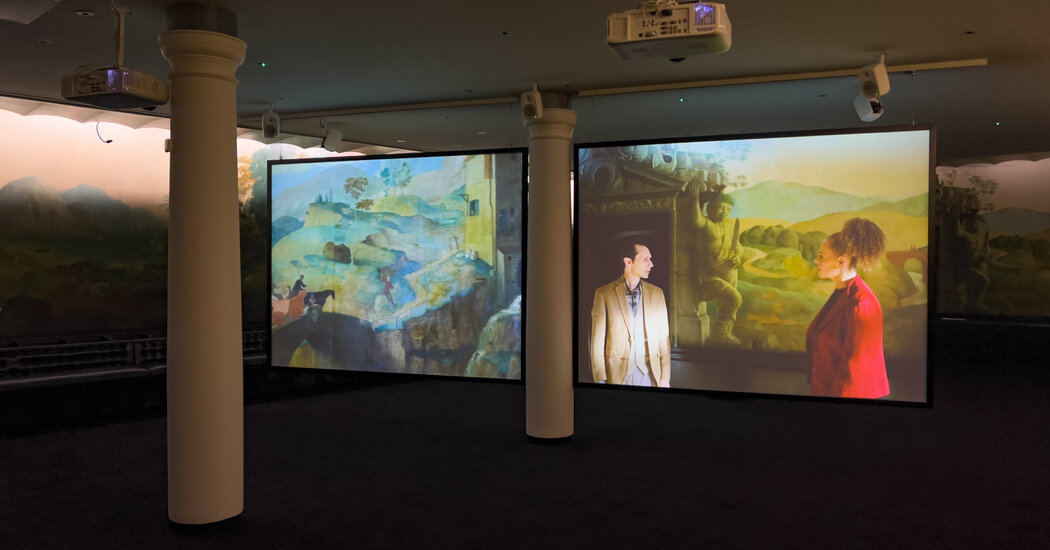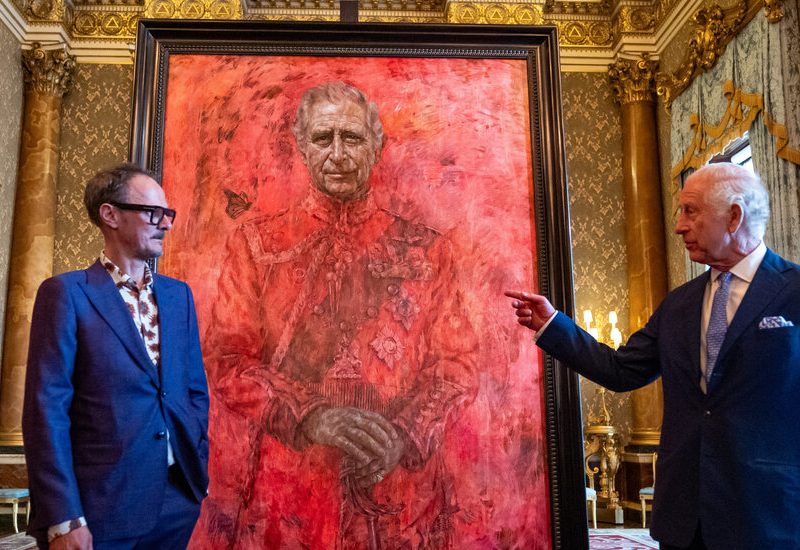For nearly 100 years, a 55-foot-long mural was the backdrop to a high-class restaurant at Tate Britain. As diners quaffed fine wine and ate expensive dishes, they could glance at the painting by Rex Whistler depicting a hunting party riding through a fantastical landscape.
Few visitors to the London art museum appeared to notice two small sections of Whistler’s scene, each taking up just a few inches: one depicting a white woman, wearing a billowing dress and bonnet, dragging a Black boy by a rope, as the boy’s unclothed, terrified mother watches from a tree; the other showing the same boy, shackled by a collar, running behind a cart.
It was only in 2020, after George Floyd’s murder and the rise of the Black Lives Matter movement, that antiracism campaigners highlighted those sections on social media and demanded the mural’s removal. Soon, Tate shuttered the restaurant, and administrators began agonizing over what to do about the painting, titled “The Expedition in Pursuit of Rare Meats.”
On Tuesday, their solution went on display when Tate Britain reopened the ornate room containing the work. Rather than diners, the mural now surrounds a large video work by the Black British artist Keith Piper that aims to highlight and explain Whistler’s racist imagery. Chloe Hodge, the exhibit’s curator, said Piper’s work would be on display for around a year.
With this new presentation, Tate Britain is trying to balance the demands of activists, who want offensive artworks removed from view, and conservative politicians and art enthusiasts, many of whom want museums to avoid any hint of “woke” posturing. But in steering a middle course between those positions, Piper said, he knew that he and the museum could annoy both sides.
“A lot of people said this is a poisoned chalice,” Piper said.
Called “Vice Voce” after the Latin name used for college oral exams in Britain, Piper’s 22-minute, two-screen film dramatizes an imagined conversation between Whistler (played by Ian Pink) and a university lecturer (Ellen O’Grady). In the film’s first half, the academic questions Whistler about the history of the mural, which the artist completed in 1927. The mood switches suddenly when she points to Whistler’s depiction of the Black mother hiding in a tree.
“Who is this?” the lecturer demands. “Oh, just a bit of humor,” Whistler replies.
The lecturer has more questions for Whistler: about the racist depictions of Black people in other artworks he produced, and about the treatment of ethnic minorities in 1920s Britain.
In the video, Whistler is confused by the line of questioning. “This is all becoming rather unsavory,” he says: “I thought you wanted to discuss my work.”
In Britain, discussions around problematic artworks have tended to focus less on an artist’s motivations and societal influences, and more on whether a sculpture or painting should be on display at all. But Whistler’s mural, which is painted directly onto the museum walls, is protected under British heritage laws, meaning Tate Britain could not easily remove or alter it, even if its administrators had wanted to. And last year, Britain’s Conservative government published guidance that said museums must “retain and explain” problematic statues or artworks that are part of a building.
Even so, some art critics and members of Tate’s own young and diverse staff urged the museum to hide the mural behind a screen.
Hodge, the curator, said that she chose Piper to respond to Whistler’s mural because she felt he would “engage deeply” with the original painting and wouldn’t produce “something reactionary.” She added that she expected the work to divide opinion. “We can’t commission work that’s going to do everything for everybody,” Hodge said: “This is Keith’s own artistic response at the end of the day.”
For decades, Piper — a founder of the Blk Art Group, a collective of Black artists formed in 1980s England — has explored issues of racism and slavery in his art. In his 1996 video work “Go West Young Man,” a father and son discuss racist stereotypes; “The Coloureds’ Codex,” a fake historical artifact Piper created in 2017, features jars of black, brown and cream paint to represent the ways that plantation owners classified and controlled enslaved people.
Zehra Jumabhoy, an art history lecturer at the University of Bristol, said that she was surprised when Tate Britain chose Piper for the commission because “his early work was so angry.” If the museum had wanted to avoid inflaming tensions around the mural, there were safer options, she added.
Yet for some artists, Piper was the obvious choice. Hew Locke, the prominent Guyanese British artist, said that Piper’s art had the bravery, historical rigor and occasional humor needed for the high-profile commission. Piper was “his own man,” Locke said, and was not out to please anyone but himself.
In an interview at Tate Britain’s cafe, Piper said that he had never eaten in the restaurant space where his work is now on show — “It was too expensive!” he said — and so hadn’t seen the mural before the uproar.
But he had not been shocked to learn that there was racist imagery on Tate Britain’s walls, he said — such stereotypical figures were once commonplace in British art. What had surprised him, though, was how long the museum took to do something about the mural. While delving into the institution’s archives, Piper said, he found visitor letters dating from the 1970s that complained about the painting.
Though the way Whistler had portrayed Black people was unacceptable, Piper said, he didn’t agree with those who had urged Tate Britain to remove the mural or hide it behind a screen. “My argument is, by leaving it up, it becomes an important witness to history, and by countering it, we learn things and we hear things, that we may not have heard before,” he said. “That’s the important role of the arts and of museums.”
After the interview, Piper walked through into Tate Britain’s newest gallery to make some final checks on “Vice Voce.” He chatted briefly with Hodge, who said that some other Tate Britain staff members had come by to see the piece. Although they liked it, she said, some had expected the film to be “more condemnatory of Rex Whistler.”
Piper looked surprised. “Isn’t it condemnatory?” he asked.
Hodge paused for a moment. “Well,” she said, “there’s always two sides.”



